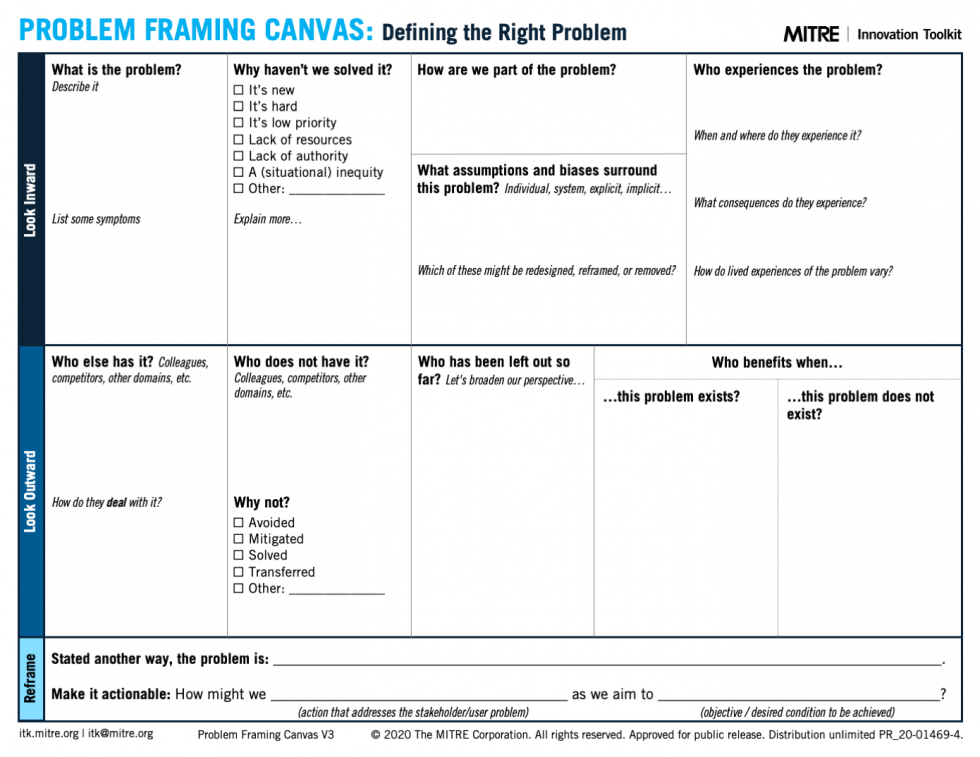Problem Framing |
 |
What is it
Explore a problem space and formulate a robust problem statement to ensure you’re solving the right problem.
Why use it
- Establish consensus about the team’s purpose
- Gain a sense of what “done” will look like
- Define the scope of a team’s initial activities and goals
- Reduce the likelihood of working at cross purposes
When to use it
When starting a project, revising it periodically to track your progress.
Level
Beginner
Outcome
Define
Group Size
2+ people
Suggested Time
45+ minutes
Problem Framing Canvas

How to do it
STEP 1
Use the canvas by yourself or in a group. Doing some quick research to collect any necessary information, statistics, or data may be helpful prior to or during the activity.
STEP 2
Begin in the upper left corner and capture some words about the problem area.
STEP 3
Work through the remaining boxes on the canvas and return to the first box throughout the process as your understanding of the problem develops. Feel free to skip any questions that do not seem to apply.
STEP 4
Use your inputs to build a problem statement in the bottom box and turn it into an actionable “How might we…” question.
Question Bank
Use these additional questions to help guide the problem framing discussion.
- What is the scope? How can we expand the scope?
- What are the elements of the problem? (Physical, social, emotional, professional, primary, secondary)
- What prevents/ hinders/ blocks other attempts, or groups, at solving this problem?
- What are we avoiding when looking at or solving this problem?
- What are the stigmas associated with this problem? Is there a stigma we’re trying to avoid?
- What are the concerns or worries others may have about this problem?
- What is unspoken about this problem?
- What language or vocabulary do we not have and need to establish?
- Who denies that this is a problem?
- How does the environment or surrounding “landscape” impact this problem? What historical contexts may be influencing or biasing (our view on) this problem?
- How are we making time to do the work that needs to be done to ensure we are designing equitably?
- Whose perspective or experience isn’t captured yet? Who doesn’t immediately come to mind but also has this problem?
- What types of inequities (uneven distribution or imbalance) exist in this problem? Power, financial, access, etc.
Note: It’s common for teams to iterate through multiple Problem Framing canvases, or complement certain sections of this canvas with other ITK tools.
Facilitation Tips
The Problem Framing canvas helps create an inclusive environment, where all members of the team are able to contribute to building a shared understanding of the problem at hand. Facilitators should take care to build a high-trust environment and ensure each participants is encouraged to speak up. This tool helps foster an adaptable mindset among groups, and they often end up coming up with new ways to describe the problem they are working on.
Produce an effective problem statement by avoiding problem statements that:
- Assign a cause
- Contain the solution
- Are based on conjecture or belief rather than fact
- Are too long
- Do not describe actual current condition or problem condition
- Do not describe the ideal or desired condition
- Are not measurable
- Are unclear
- Are not specific
- Refer to issues outside of the scope of the actual problem
Benefits
You can’t waste time on this tool! It could be a 30-second exercise if team is on same page. If it takes longer than 30 seconds, that is time worth spending.
Challenges
- These questions can be difficult to answer in an insular team and may require some collaborative conversations with other folks to broaden your perspective.
- To truly bring in the equity lens, requires a facilitator who knows how to lead the discussion to help the team broaden their thinking, understand assumptions & biases they inherently bring with them, and think of non-primary populations/stakeholders that may be impacted.
Combine With
- Lotus Blossom beforehand to brainstorm problem areas, Lotus Blossom afterwards to brainstorm possible solutions
- Stakeholder Identification Canvas to better understand who does/doesn’t benefit
- TRIZ Prism to solve the specific problem you come up with in the Problem Framing canvas
